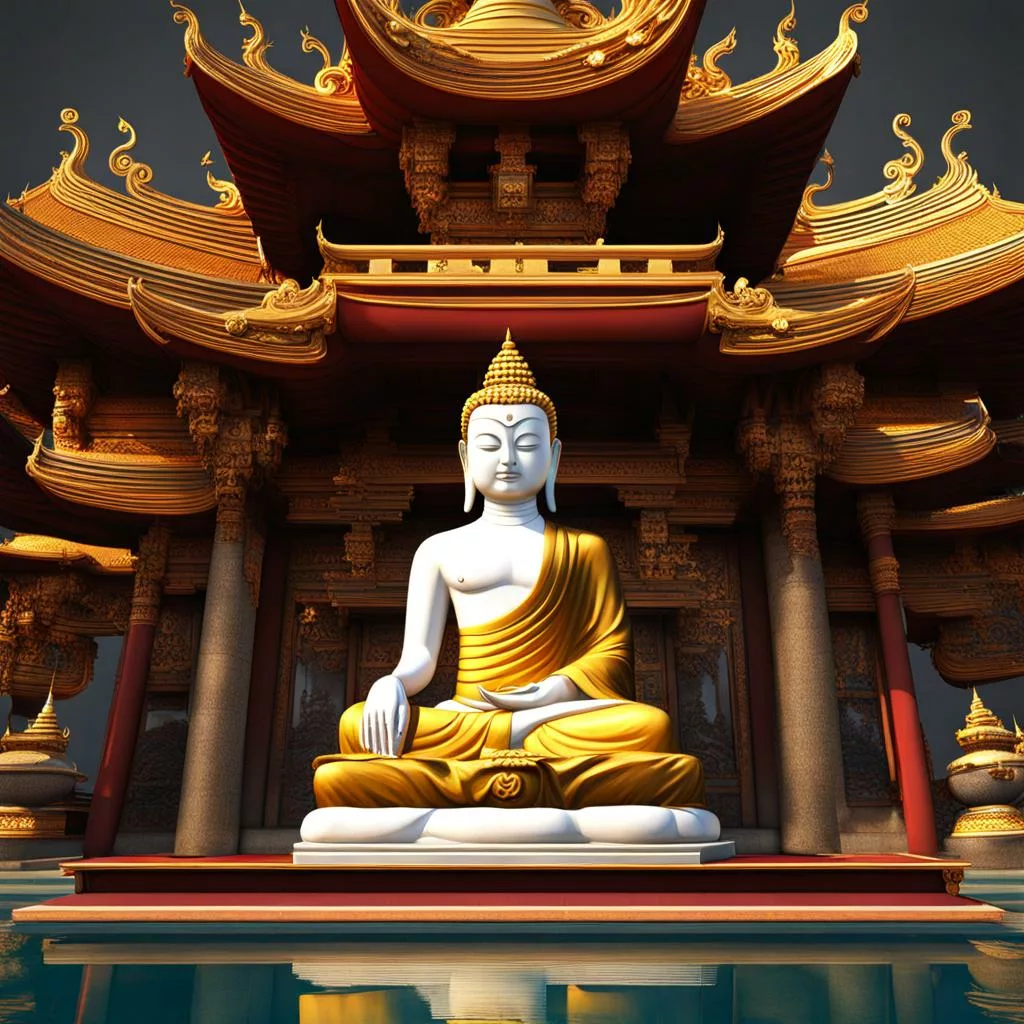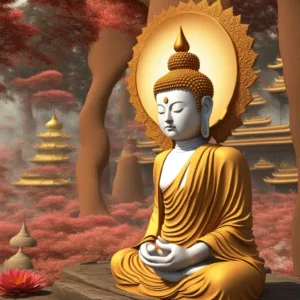
Nirvana meaning in Buddhism is the cessation of suffering from overcoming ego, hence not being compelled to take rebirth in the six realms. Nirvana, though extremely profound, is far lesser an attainment than full enlightenment.
Table of Contents
Buddhist Nirvana Summary
| Entity | Description |
|---|---|
| Nirvana | The ultimate goal of the Buddhist path, a state of liberation from suffering |
| Religion/Practice | Primarily Buddhism (Theravada, Mahayana) |
| Characteristics | * Freedom from suffering (dukkha) * Extinction of the three poisons (greed, hatred, delusion) * Perfect peace and lasting happiness * The end of the cycle of rebirth (samsara) |
| Theravada vs. Mahayana | * Theravada: Nirvana is achieved through individual effort, leading to Arhatship (liberation for oneself). * Mahayana: Nirvana is achieved through compassion and the desire to help all beings reach enlightenment (Buddhahood). |
| Path to Nirvana | * Following the Noble Eightfold Path * Meditation practice (Vipassana, Samatha) * Ethical conduct (Sila) * Cultivating wisdom and compassion |
| * Theravada emphasizes self-reflection and detachment. * Mahayana emphasizes helping others and skillful means (upaya). | |
| Importance | Nirvana is the core goal of Buddhist practice, representing the end of suffering and the ultimate liberation. |
| Additional Notes | * Nirvana is a complex concept with various interpretations * It’s not a place but a state of awakened awareness * The path to Nirvana can be gradual and requires dedication * There are many teachings and practices to support the journey towards Nirvana |
nirvana meaning in hindi
Nibbana / nirvana meaning in Hinduism is somewhat different than Buddhism.
Nirvana means ‘moksha’ or ‘mukti’ in Hindi. It is a Sanskrit word that expresses the sense of ‘conclusion’, ‘peace’ or ‘free from bondage’. Nirvana is a state in Buddhism and Jainism where a person becomes free from all worldly bondages and bondages. It reflects the state of spiritual peace and permanent bliss in human life. Attaining Nirvana means freeing yourself from worldly desires and attachments and attaining supreme knowledge and peace.
how do you reach nirvana in Buddhism?
Reaching Nirvana, or enlightenment, in Buddhism is not a simple or straightforward process. It requires a deep understanding of Buddhist teachings, as well as a commitment to spiritual growth and personal development. Here’s a general guide on how to reach Nirvana in Buddhism:
1. Understanding the Four Noble Truths: The Four Noble Truths are fundamental teachings in Buddhism. They are: the truth of suffering (Dukkha), the truth of the cause of suffering (Samudaya), the truth of the end of suffering (Nirodha), and the truth of the path that leads to the end of suffering (Magga).
2. Following the Eightfold Path: The Eightfold Path is described in the fourth Noble Truth. It is a guide for ethical conduct, mental discipline, and wisdom. The path includes right understanding, right thought, right speech, right action, right livelihood, right effort, right mindfulness, and right concentration.
3. Meditation and Mindfulness: Buddhism places a large emphasis on meditation and mindfulness as a means to achieve Nirvana. It involves focusing your mind and understanding your thoughts and feelings without judgment. This can help you gain insight into the nature of reality and your own existence.
4. Wisdom and Morality: Gaining wisdom is a key element in reaching Nirvana. This can be achieved through the study of Buddhist teachings, as well as through personal experience. Practicing morality, such as being truthful, generous, and compassionate towards others, is also crucial.
5. Letting Go: Attachment is seen as a cause of suffering in Buddhism. Therefore, letting go of desires, material possessions, and even personal identities can be a step towards achieving Nirvana.
6. Practice Patience and Perseverance: The journey to Nirvana is not easy. It requires patience, dedication, and constant effort. It’s not about reaching a destination quickly, but about understanding and enjoying the journey.
7. Seek Guidance: Having a spiritual teacher or joining a Buddhist community can provide valuable guidance and support. They can help explain complex teachings and provide practical advice on how to incorporate Buddhist principles into daily life.
Remember, reaching Nirvana is a personal and individual journey. It’s about finding peace and understanding within oneself. While these steps can guide you, the path may be different for everyone.
nirvana buddhism symbol

The Nirvana symbol in Buddhism is often represented by the flame, an empty circle, or the lotus flower, signifying the ultimate state of enlightenment and liberation from the cycle of rebirth and suffering.
The term “Nirvana” translates to “blowing out” or “quenching”, it represents the extinguishment of desires, attachment, and ignorance, which are the root causes of suffering according to Buddhist teachings. The attainment of Nirvana is the ultimate goal in Buddhism, marking the end of karmic rebirth and resulting in a state of eternal peace and happiness.
nirvana meaning slang
In slang usage, “nirvana” typically refers to a state of perfect happiness, peace, or enlightenment. It is often used to describe an ultimate goal or dream, or a state of being that is so ideal and blissful that it is considered the pinnacle of one’s desires or aspirations. This usage is derived from the term’s origins in Buddhism, where Nirvana is the ultimate spiritual goal, representing liberation from the cycle of rebirth and suffering. In everyday conversation, however, “nirvana” might be used to describe anything from a perfect vacation spot to an ideal state of mind.
Understanding the Essence of Nirvana: Exploring its Profound Meaning in Buddhism
Nirvana, a term often associated with the band Nirvana and their iconic frontman Kurt Cobain, holds a much deeper and profound meaning in the realm of Buddhism. In Buddhist philosophy, Nirvana represents the ultimate goal of spiritual liberation and enlightenment. It is a state of complete liberation from suffering and the cycle of birth and death, known as samsara. To truly understand the essence of Nirvana, one must delve into the core teachings of Buddhism and explore the profound meaning it holds.
In Buddhism, suffering is considered an inherent part of existence. The Four Noble Truths, the foundational teachings of Buddhism, state that suffering exists, it has a cause, it can be overcome, and there is a path to overcome it. Nirvana is the ultimate realization of this path, where one transcends suffering and attains liberation. It is often described as the extinguishing of the fires of desire, ignorance, and attachment that fuel the cycle of suffering.
The concept of Nirvana can be challenging to grasp, as it goes beyond the limitations of language and conceptual understanding. It is often described as an experience that is beyond words, thoughts, and concepts. The Buddha himself said, “There is, monks, an unborn, unbecome, unmade, unconditioned. If there were not that unborn, unbecome, unmade, unconditioned, there would not be the case that escape from the born, become, made, and conditioned would be discerned. But precisely because there is an unborn, unbecome, unmade, unconditioned, escape from the born, become, made, and conditioned is discerned.”
Unveiling the Spiritual Significance of Nirvana in Buddhist Philosophy
The spiritual significance of Nirvana in Buddhist philosophy lies in its ability to liberate individuals from the cycle of suffering and bring about true enlightenment. It is not merely a state of bliss or happiness, but rather a state of complete freedom from the limitations of the ego and the illusions of the material world. Nirvana is the ultimate realization of the true nature of reality, where one sees through the transient and impermanent nature of existence.
In Buddhist philosophy, the ego is seen as the root cause of suffering. It is the attachment to the self and the constant craving for pleasure and avoidance of pain that keeps individuals trapped in the cycle of samsara. Nirvana is the state where the ego is transcended, and one realizes the interconnectedness and interdependence of all things. It is the dissolution of the illusion of separateness and the recognition of the inherent emptiness of all phenomena.
The spiritual significance of Nirvana can be seen in its transformative power. It is not a state that can be achieved through external means or material possessions. Instead, it requires a deep inner transformation and a shift in consciousness. The Buddha taught that the path to Nirvana involves cultivating wisdom, ethical conduct, and mental discipline. It is through meditation, mindfulness, and the practice of compassion that one can gradually purify the mind and attain liberation.
The Path to Nirvana: A Journey towards Enlightenment in Buddhism
The path to Nirvana is not an easy one. It requires dedication, discipline, and a deep commitment to self-transformation. The Buddha outlined the Noble Eightfold Path as the means to attain Nirvana. This path consists of right view, right intention, right speech, right action, right livelihood, right effort, right mindfulness, and right concentration.
Right view involves understanding the true nature of reality and the causes of suffering. It is the recognition that all things are impermanent and interconnected. Right intention involves cultivating wholesome intentions and letting go of harmful desires. Right speech, action, and livelihood involve ethical conduct and the avoidance of harm to oneself and others. Right effort involves the cultivation of positive qualities and the abandonment of negative ones. Right mindfulness involves being fully present and aware of one’s thoughts, feelings, and actions. Right concentration involves the development of focused and concentrated states of mind through meditation.
The path to Nirvana is not a linear journey but rather a gradual process of self-discovery and transformation. It requires patience, perseverance, and a willingness to confront and let go of deeply ingrained patterns of thought and behavior. It is through the cultivation of mindfulness and the development of wisdom that one can gradually purify the mind and attain liberation.
Embracing Nirvana: How Buddhist Practices Lead to Liberation and Inner Peace
Buddhist practices play a crucial role in leading individuals towards the realization of Nirvana and the attainment of inner peace. Meditation, mindfulness, and the cultivation of compassion are key practices that help individuals transcend suffering and find liberation.
Meditation is a central practice in Buddhism, as it allows individuals to cultivate a calm and focused mind. Through meditation, one can develop insight into the nature of reality and gain a deeper understanding of the impermanent and interconnected nature of existence. Meditation also helps individuals develop mindfulness, which is the ability to be fully present and aware of one’s thoughts, feelings, and actions. Mindfulness allows individuals to observe their experiences without judgment or attachment, leading to a greater sense of inner peace and freedom.
Compassion is another essential practice in Buddhism. It involves cultivating a deep sense of empathy and care for all beings. By recognizing the interconnectedness of all things, individuals can develop a genuine concern for the well-being of others. Compassion not only benefits others but also brings about a sense of inner peace and fulfillment. It is through the practice of compassion that individuals can overcome the ego and let go of selfish desires, leading to a greater sense of liberation.
Conclusion: Nirvana Meaning in Buddhism
Nirvana holds a profound meaning in Buddhism. It represents the ultimate goal of spiritual liberation and enlightenment, where one transcends suffering and attains true freedom. Understanding the essence of Nirvana requires delving into the core teachings of Buddhism and exploring its spiritual significance. The path to Nirvana involves cultivating wisdom, ethical conduct, and mental discipline through practices such as meditation, mindfulness, and compassion. By embracing these practices, individuals can embark on a transformative journey towards liberation and inner peace.

May all beings be happy
May all beings be peaceful
May all beings be safe
May all beings awaken to the light of their true nature
May all beings be free








